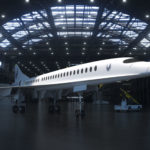Airbus CEO Guillaume Faury says the aerospace industry is seeing signs of recovery after a bleak couple of years. Faury shared his optimism about the post-Covid future with new, sustainable technologies such as hydrogen propulsion and urban air mobility continuing to progress.
Resilience and the willingness to commit to reducing and eliminating carbon emissions are set to bolster confidence and bring a new found resilience to aerospace manufacturing, according to Airbus CEO Guillaume Faury.
Although the OEM is still experiencing supply chain issues, he added demand was still strong, supported by the backlog and recent orders from the Dubai Airshow. Faury explained: “We were on the path of growth before we were hit by the pandemic, like everybody, I think the industry as a whole has been very resilient. And we’ve worked hard together to make sure we would survive the crisis altogether, so a lot of work with customers, with suppliers and the supply chain is really stretched by this crisis, and also a lot of work inside the company to make this possible. And I think employees of Airbus are very proud of what they have accomplished again.”
Global warming is “first global challenge to humanity”
Faury said he believed aviation had important roles in trade, tourism and connecting people, but added that the industry must demonstrate its commitment to achieving global sustainability targets: “Global warming is probably the first global challenge to humanity. And we want to be part of the solution,” he said.
“We are believers in the fact that we have to be fast – that each and every tonne of carbon that is put in the air today today will contribute to global warming. So there is urgency, but we see solutions. And the more we work, the more solutions we see, there’s a lot of work to be done. It’s about the planes, it’s about the fuels, and the energy sector has to back us, but also about the level playing field in terms of regulations that need to be created.”
Airbus projects include increasing aircraft efficiency to reduce emissions, use of sustainable aviation fuels (SAF) and hydrogen propulsion. Explaining Airbus’ work on introducing new hydrogen propulsion aircraft, Faury said: “Because it’s feasible, it’s possible. It’s a lot of engineering work, for sure, that’s what we’re doing now.”
“But hydrogen is the only way to have a fuel on board that doesn’t put carbon in the air, in condition or when being used on board. So we are working on all those those paths and we are trying to be as fast as we can. And we are very happy to see the momentum growing. We had recently the Airbus Summit in Toulouse a lot of people joining, because I think everybody that believes in aviation, wants to be part of the success of that story.”
Airbus aims to deliver first hydrogen plane in 2035
Airbus is aiming to deliver its first hydrogen plane in 2035. “We started the development of the technologies two years ago,” explained Faury, “ We think we need roughly five years to mature those technologies, they are based on existing things and we don’t need to reinvent the rules of physics.”
“We’re using technologies that are applied in other sectors, which is developing those technologies for aviation, then we need two years to prepare the launch of the programme, finding the partners, the location for the plants and preparing the industrial system that we need, and preparing contracts and funding of these big investments. So 2027-2028, we’ll be ready to launch the programme. And then it takes to 2035 to be certified and, in turn, to sell it. So the credibility of this timeframe is very strong. And we continue to make progress. I remain very optimistic that we’re going to make it.”
UAM: “Fail fast, learn from it, try again”
The emerging UAM sector would also help create sustainable urban transportation solutions, alleviating both congestion and pollution within cities. But with many of the models relying on battery power, Faury added there were still plenty of challenges for the sector to overcome.
“At Airbus, we also like the idea that those technologies can be experimented on those other small products, quickly. We can fail fast, learn from it, try again with different solutions. And when this is successful, we can scale it up to other products and in particular to commercialisation. So we see the two benefits of working on those technologies. When? Maybe 2025, 2026, 2027, we will see the first one flying commercially – and I’m sure we will be flying those products in our lifetime.”

